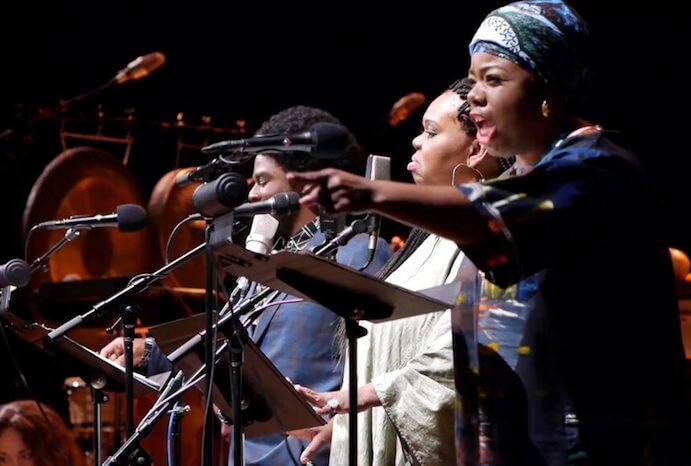“Black folks do not issue ultimatums to white folks in Mississippi … we had to get out!” rang tenor Julian Terrell Otis in the New York City preview of George Lewis’ Afterword: The AACM (As) Opera. The opera’s concert version premiere at Roulette foreshadowed a full premiere on October 16, 2015 at the Museum of Contemporary Art in Chicago. Afterword uses musical relationships to mimic and explore the history of the Association for the Advancement of Creative Musicians and offers an uncensored window into the collective’s internal politics.
The May 22, 2015 preview showcased the first act, comprised of seven vignettes representing the formation of the AACM. The libretto was constructed from verbatim dialogue from Lewis’ 2008 book of historical research, but he is emphatic that the opera is not a historical re-enactment but an extraction and exploration of drama occurring within a historical situation. The scene summaries with names such as “Down South,” “The Cemetery,” and “Naming Ourselves” reflect this clouded specificity, and an atmospheric opening with smattered percussion and asthmatic strings wheezing at the top of their register set the mood.
In a nod to the AACM’s two chapters, vocalists contralto Gwendolyn Brown, soprano Joelle Lamarre, and tenor Julian Terrell Otis hailed from Chicago while the International Contemporary Ensemble represented New York City with piano, horn, violin, cello, flutes, clarinets, percussion, and audio engineering. Each vocalist was an avatar who resurrected the words of several unnamed AACM members. Brown, Lamarre, and Otis embodied their many personas persuasively, fluidly moving through emotions and actively engaging with one another’s narrations.
Julian Terrell Otis, Gwendolyn Brown, and Joelle Lamarre– Photo by Ross Karre.
In the first three brief scenes there was no clear lead character, and at his most forceful, the tenor emerged only as a moderator of group discussions. Despite Lewis’ attempt to represent all members equally, however, he couldn’t avoid the dominant personality of Richard Muhal Abrams. As one of the collective’s co-founders and one of its defining philosophical voices, Abrams emerged as a recognizable voice even in anonymity. It was sometimes difficult to understand a solo vocalist, but when two or three sang together it was nearly impossible. A large part of the opera’s distinctive beauty – the poetics of real, everyday speech – was lost and the dramatic tensions were diminished. Clearer diction and tailored amplification balances will improve the opera’s full premiere and more fully engage the audience in its drama.
“Original music…”
“Is that all we will allow? We will become slaves [if it’s only] original music…”
The opera’s drama came not from an ancient myth or traditional literary conflict, but from external antagonistic forces motivating the characters to confront their limitations. It seemed initially as though the instrumentalists accompanied the drama in a very traditional sense, even as Lewis utilized timbre, tempo, and rhythm in place of melody to support the emotional experience of each character. The orchestration was calmly atonal, with melodic snatches in place of any theme and a sense of endless improvisation. The ensemble transitioned the narrative: one character could finish a melancholic line and Michael Nicolas and Kiku Enomoto gently prepared new emotional space for the next dialogue with two or three beats of solo strings.
However, an invigorated relationship between this narrative and the orchestra was one of the opera’s distinctive traits. Guided by the opera’s larger structure, ICE did in real time what the vocalists re-enacted in narrative as the music evolved from notation to improvisation. After three of the narrative sequences, the vocalists retired in darkness and the spotlights brightened as the orchestra emerged as a narrative focal point. Scene two’s improvisation recreated an urban soundscape: the horn mimicked car sounds and Ross Karre turned the percussion jazzy in transition to 1960s Chicago. “We will take control like the great musicians of the past. Let’s get together…” the vocalists sang at the end of scene three, and the ensemble pulled out all the stops before the night’s first dramatic cutoff.
Afterword: The AACM (as) Opera– Photo by Ross Karre.
The fourth vignette featured a major group dialogue amongst characters and was mimicked by a vibrant ensemble improvisation. David Byrd-Marrow on horn tapped inside and outside the bell and played valves as percussion; Cory Smythe plucked strings inside the piano. Alice Teyssier on flutes punctured Nicolas’ cello solo with piercing and powerful pitch, until Joshua Rubin on clarinets returned the favor and the two wind instruments jostled to be heard. After the sixth vignette, the ensemble sat back and the vocalists finally had their moment to improvise in scatting, trilling, moaning, clicking, and exploring of every pitch and timbre their vocal instruments produced. Ultimately, Lewis’ orchestration elevated the ensemble as equally interactive characters that played a vital role in the matrix of performance elements and connected its historical arc to the immediate moment.
“What are we calling it: creative music or musicians?”
“Creative musicians!”
This flux relationship between notation and improvisation emerged as the ultimate commentary on the AACM’s history. The collective formed in tension between the two poles of notated classical music and free jazz improvisers, unable to force itself into one camp. Instead, the early members of the AACM explored how they could claim creative territory in the middle and allow their group members the freedom to benefit from all musical traditions. Notation functioned most importantly as a unifying dramatic device rather than a creative prescription; like in the collective’s primordial discussions, the tension between form and freedom tied Afterword’s disparate forces together. Ten musical artists held together creating a whole, sometimes unified and sometimes dissenting in a give and take between collectivism and individualism. This elevation of the orchestra and reconsideration of improvisation’s potential in opera formed a meta-integrity that was the work’s most singular accomplishment: it is an honorable dramatization of the AACM’s past and an important contribution to the collective’s contemporary work.

